Table of Contents
- Combine media databases, Google News, and X/Twitter to pinpoint highly relevant journalists by beat and recent coverage.
- Prioritize assignment editors and reporters when pitching; avoid general newsroom emails unless unavoidable.
- Use BuzzStream for bulk journalist research, contact discovery, and personalized outreach sequencing at scale.
- Improve deliverability and ROI by crafting hyper-targeted, pitch-ready emails journalists can publish from directly.
- Platforms like Qwoted, HERO, and X’s #journorequest offer opportunistic ways to respond to journalist quote requests.
Imagine a world where journalists saw every piece you published.
Unfortunately, that world doesn’t exist.
We need to work for our coverage, get it in front of the right people, and share our stories.
For some in the social media space, these are influencers. Others rely on bloggers. In the digital PR world, journalists and reporters promote our content.
Some journalists love to get pitched great stories. But they are so bombarded with irrelevant stories and weak pitches that they don’t put their email addresses front and center.
This post isn’t about writing a media pitch because we’ve already done that. Instead, let’s discuss the most effective (and ethical) ways to contact reporters and journalists.
How to Find Journalists Interested in Your Story
There are at least six main ways to find journalists.
1. Use a Media Database to Find Reporters and Journalists
Media databases are the most obvious starting point for finding journalists in your industry. We cover a lot of media database tools in our post about digital PR tools, but some of the most used are:
For example, if I were writing a post about farming, I could search MuckRack with a keyword like “farming,” it would uncover journalists in their database who talk about farming.

Media database tools typically include the journalists’ email addresses and contact details.
However, the downside of media databases is that they typically get outdated quickly. In our post about building your own media list, we discuss the importance of verifying a target journalist’s industry (and contact information).
In our example, let’s imagine the post we will pitch covers something specific to Tennessee farming.
If we wanted to contact Lee Maddox from our screenshot above, I’d click on Lee Maddox to see what they have written about recently.
MuckRack displays recent Tweets from X, which gives me some idea of his current posts:

But I’d still like to click on his site, Tennessee Farm Bureau News, to evaluate whether the site is a good fit.

The most recent news story is about new USDA news.
The next is about an emissions study with some colorful graphics.

There is a good chance that this site may be open to our study.
No specific authors are listed in the News section posts, so Lee may be the best person to pitch to get a story included. So we can add him to the list.
You could continue using your media database tool to find more journalists or pivot to find journalists on social media.
2. Find Relevant Journalists on Social Media
According to Muck Rack’s State of Journalism report, X/Twitter is still the number-one place journalists go for news.

So, let’s focus on that platform as it’s the dominant area where journalists are active.
Finding Journalists on X
To find journalists on X, try a generic search in their search bar and then toggle to People.
For example, searching “farming news” will show us people who include “farming news” in their handle or description.

This search has uncovered publications, which we can use to search the site for relevant journalists, as outlined in the next section.
Let’s try to focus on reporters. We’ll use X’s Advanced Search feature, which allows you to be a little more creative with your searches.

I’m searching for any profiles that include farming, agriculture, or agriculture and “reporter.”

Ah, much better.
Now, I can click on these journalists’ profiles, see what they have written about recently, and gauge their relevance to my story.
If you’re lucky, the journalist will share every article they write on X, giving you insight similar to what you saw in the previous MuckRack example.
However, this isn’t always the case. Some journalists use X for personal news as well.
So, I’ll walk you through my workflow.
Let’s pretend our post concerns farming in Ireland, so I chose Kathleen O’Sullivan, a farming reporter for the Irish Examiner.
I see that she most recently posted on April 9 (over a month ago), and it isn’t a story she’s written (it’s one she’s reposted). So far, I don’t have a lot of confidence.

But we need to keep digging. I need to go to the Irish Examiner and see if I can find her most recent articles.

I navigate to Farming News on the Irish Examiner’s site and open a few articles.
Luckily, the first article I opened looks like it was written by Kathleen O’Sullivan—and it was written one day ago.

That’s good enough for me. I’ll add her to my list!
Some like to go a different route to find interested journalists and seek websites or articles via Google search.
3. Find News Sites on Google
To find journalists to contact about your post or story, you can always start by finding similar news sites and then identifying journalists to build your media list.
So, continuing our farming example, let’s perform a Google search for farming news.

This will give me generic farming news sites. Then, I can dig further into each page to find a relevant journalist interested in my post.
For example, let’s click on Successful Farming.

Now, I want to find relevant journalists.
I found an author in one recent article named Natalina Sents Bausch.

Now, confirming that Natalina writes about our topic frequently is essential. Given that this is a farming-centric publication and her bio confirms it, we can reasonably be sure this is true.
However, for illustrative purposes, I’ll still show how to confirm.
Let’s confirm Natalina writes about our topic frequently enough to be interested in our pitch.
If I click on her name, I’m taken to her author page, which is pretty standard practice UX for a publication.
When I do this, I can see all of Natalina’s recent posts—all about farming.
Jackpot!

Some sites display the date on an author page like this, but you can click on each to confirm the publication date.
I see that these are very recent.


Finding websites and publications and then identifying journalists can be time-consuming. Some prefer to find specific articles related to their pitch, which gets them closer to the journalist.
4. Find Similar Articles on Google News
To find similar articles using Google when contacting reporters, I recommend using Google News rather than Google Search. Both work, but Google News will get you the articles you seek more quickly.
Let’s type farming into Google News.
By default, Google News will display the most recent articles.

Again, although these are recent articles written by a journalist, it’s always critical to check that the journalist writes about this industry frequently. (Oftentimes, a journalist might jump onto a new beat for only one article and then jump back off.)
So, let’s click on the Guardian result and see if this reporter is a good fit.
We see that Jessica Murray is a correspondent for the Midlands area.
Maybe she covers farming in the Midlands! (UK readers most likely already know what’s coming.)
Let’s click on her name to take us to her author page.

Unfortunately, it looks like she covers all different news topics. I see everything from Birmingham City Council news to museum-related news.
But if she was interested in farmers in Shropshire, wouldn’t she be interested in my piece!?
Not necessarily. If our farming post were explicitly about a significant piece of farming news in the Midlands, perhaps she’d be a little more interested.
But the fact that she covers such a wide beat for the Midlands area, I’d pass on Jessica.
Then, it’s back to the Google News results to find a new article.
By adding extra keywords to your search queries, you can get more specific. For example, you can find journalists who have written about your posts.
For instance, if our farming post was about drought-resistant crop innovations, we could search for queries like “drought-resistant crops,” “drought news,” and “farming technology innovation.”
However, this approach of searching for single terms can get pretty tedious. That’s where BuzzStream comes in.
5. Use ListIQ
I can use BuzzStream’s new media list building tool, ListIQ, to combine all of the previous steps and build a hyper-targeted media list right from Google News results.
First, I do a Google News search for ‘farming’ and enable ListIQ.
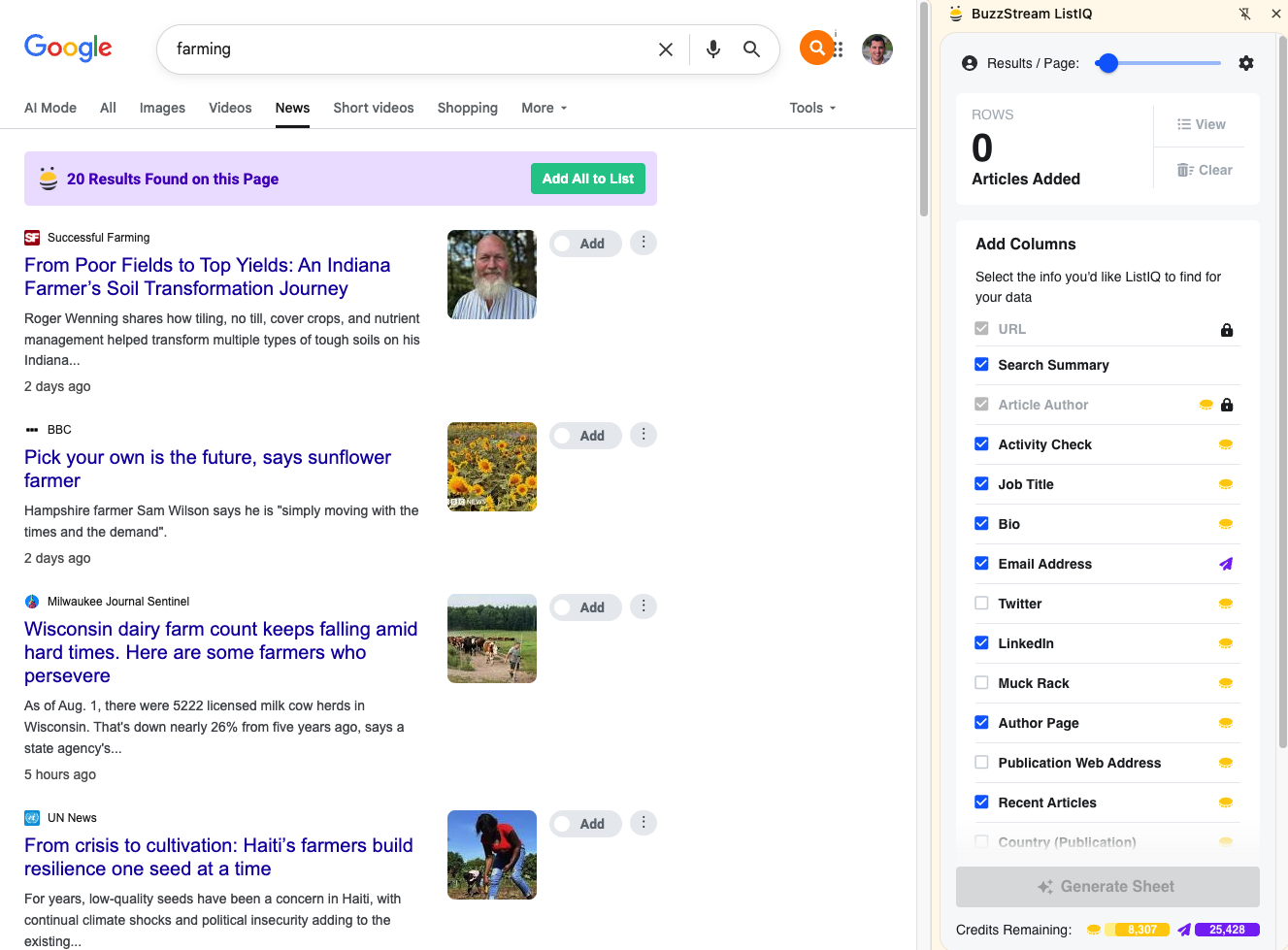
Then I add any/all of the URLs that I want ListIQ to scan for information to build my list.
Here, I’ll just choose Add All to List:
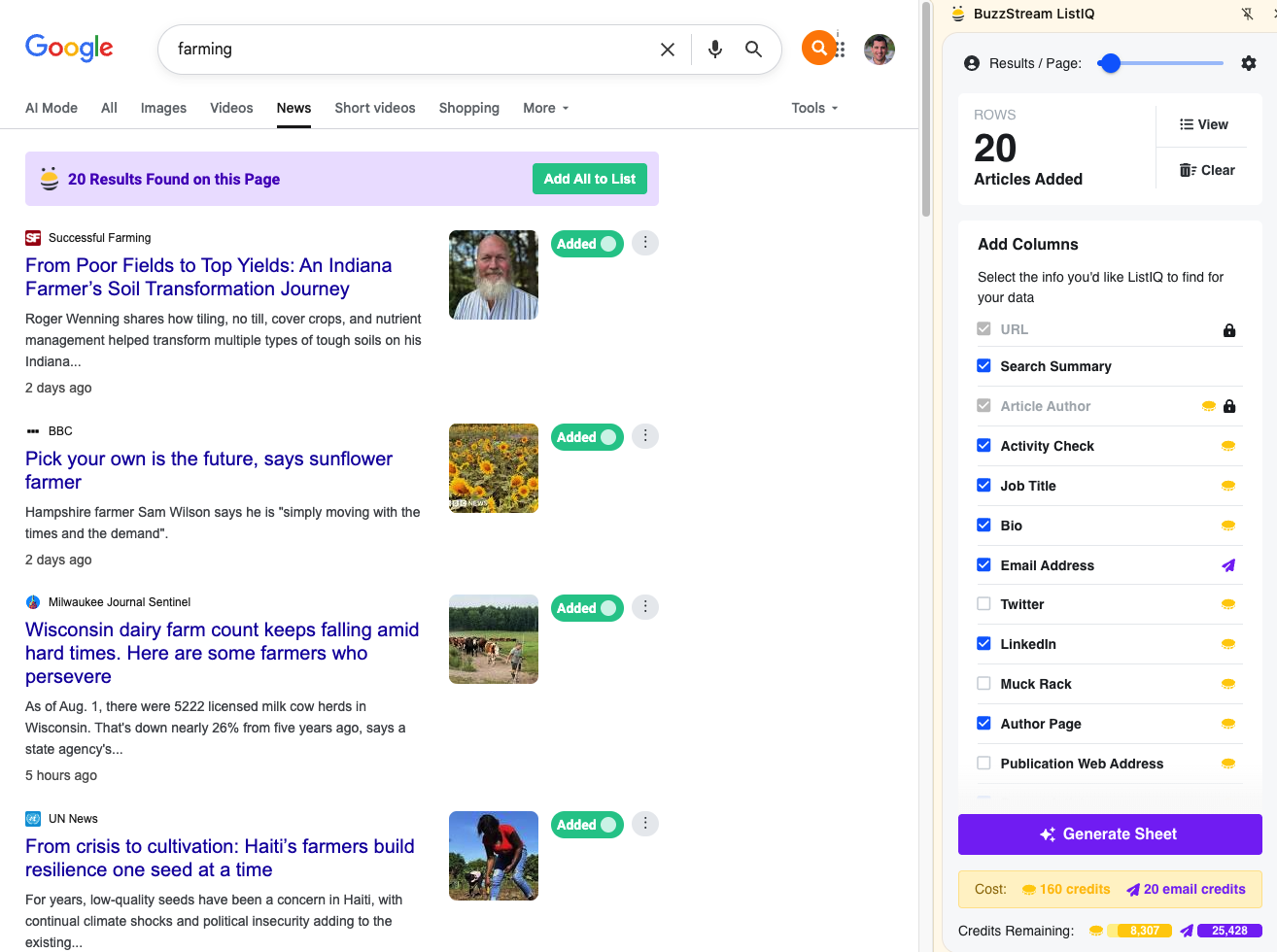
Then, I click Generate Sheet, and in a few seconds, it’s pulled Activity Checks, Job Title, Bio, Email Addresses, Author Pages, and everything else I’ve selected:
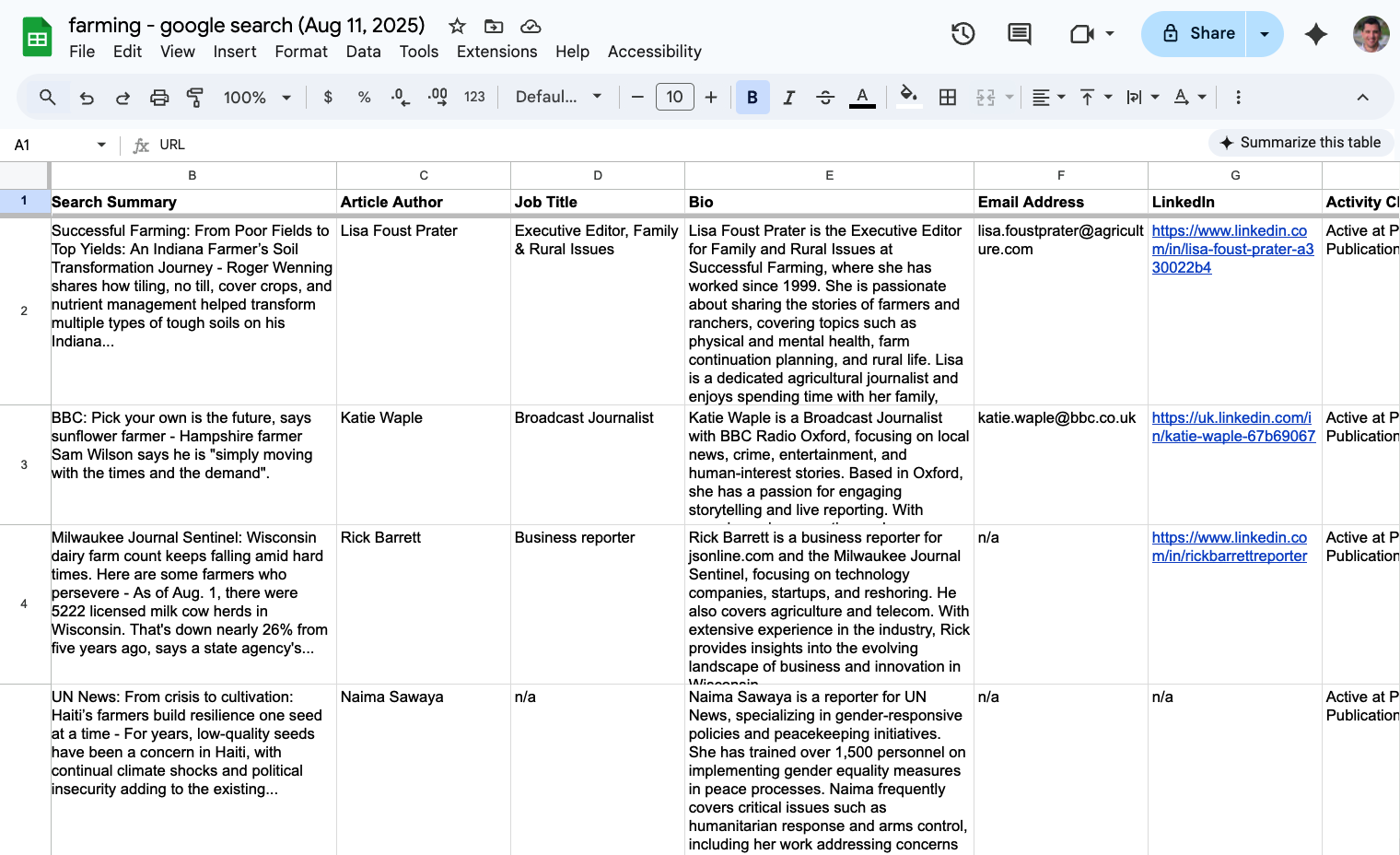
Now, instead of needing to go into each URL and find the author, I can quickly identify who is relevant or who isn’t based on their bios.
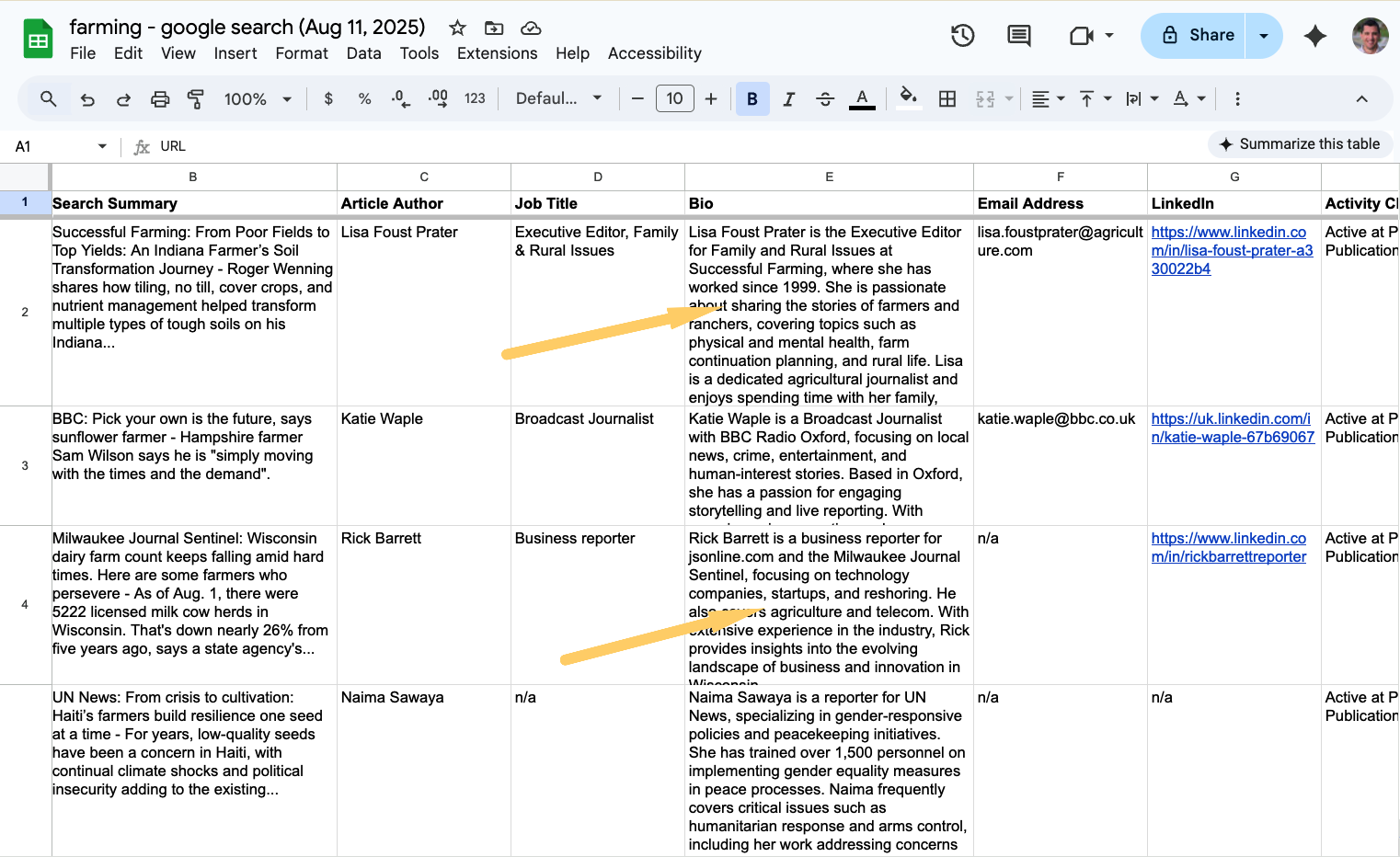
I would also quickly remove the two other journalists in the screenshot, Katie Waple and Naima Sawaya, based on their bios, because they don’t cover farming at all.
Then, I can just save this list and use it as my media list.
6. Search for Journalists Based on Their Role
In more traditional newsrooms, there are specific roles that are better suited for pitching your story than others.
Some prefer to find a news site and search for the person in the specific role.
You can do this using the aforementioned media list, but you can also search the site once you’ve identified it.
Most news sites provide a list of contacts.
You can find their team roster by searching for pages entitled Contact Us, About Us, Staff, or Our Team. Typically, these are found in the footer of a news site.
For example, if I wanted to contact the local NBC news site in Connecticut, I’d find the contact page in the footer and see a list of their staff.

Then, clicking on the names, I’d look for the assignment editor or relevant reporters.
To better explain who to prioritize when pitching your news, I asked Nicole DeLeon and her team from the content marketing agency North Star Inbound.
Here’s what they said:
Who Should You Prioritize When Pitching a Story to a Newsroom?
In order of importance…
- Assignment editor
- Reporters & producers
- Executive producer
- Digital producer/web team*
- Anchor
You could probably switch the executive producer title to the editor in non-broadcast newsrooms.
Why Should You Prioritize Pitching Assignment Editors?
Assignment editors are the newsroom’s center (literally and figuratively).
Their job is to organize incoming emails, often from the general newsroom email and their personal emails, so that they can be directed to the right person.
If they see a press release with relevant or interesting information for their audience but not in-depth enough for a full reporter story, they will send it to the producers.
When they see information relevant to a story one of the station’s reporters is already working on, they will send it along to that reporter.
They also often run the morning and evening pitch meetings, sharing with the team the most exciting and relevant press releases they’ve seen.
But Reporters and Producers Are Also Important
Reporters are often responsible for developing their own story ideas and pitches. They have a lot of sway in the newsroom.
If they see an interesting pitch they think they can expand on and pitch it well enough, they will do just that.
Producers are in charge of their shows.
There are many spots in an hour or half-hour newscast to fill, some as small as a 15-second story.
Why Anchors Are at the Bottom of the List
Many anchors just read what is given to them and written for them. Those who work on their own stories don’t do it nearly as often as reporters do.
Reporters produce a story or more every day. Anchors, IF they work on their own stories, do it maybe once a week or a few times a month.
Now that you know who to pitch to, let’s discuss how to contact them.
How to Contact Journalists and Reporters
Contacting journalists and reporters is typically best done by email. In this section, I’ll discuss finding contact information, crafting emails, and messaging using different platforms.
1. Find Their Contact Information
Once you know who to reach out to, you need to find their contact information.
Many news sites include contact information right on their author or staff pages. For example, if I looked at the same Connecticut list, I could see the contact information for reporter Heidi Voight.

Journalists who want to be found can typically be located fairly easily.
You can even see her email address right on her Facebook page.

But what if you run into those sites that don’t advertise their reporters’ contact info?
I covered how to find everyone’s email addresses extensively already, so I won’t discuss it too deeply, but I’ll call out three tips:
ListIQ
As I mentioned earlier, you can find contact information at scale right from a Google News search using ListIQ.
For instance, returning to the farming example, I can quickly verify the email addresses of each journalist on the list.
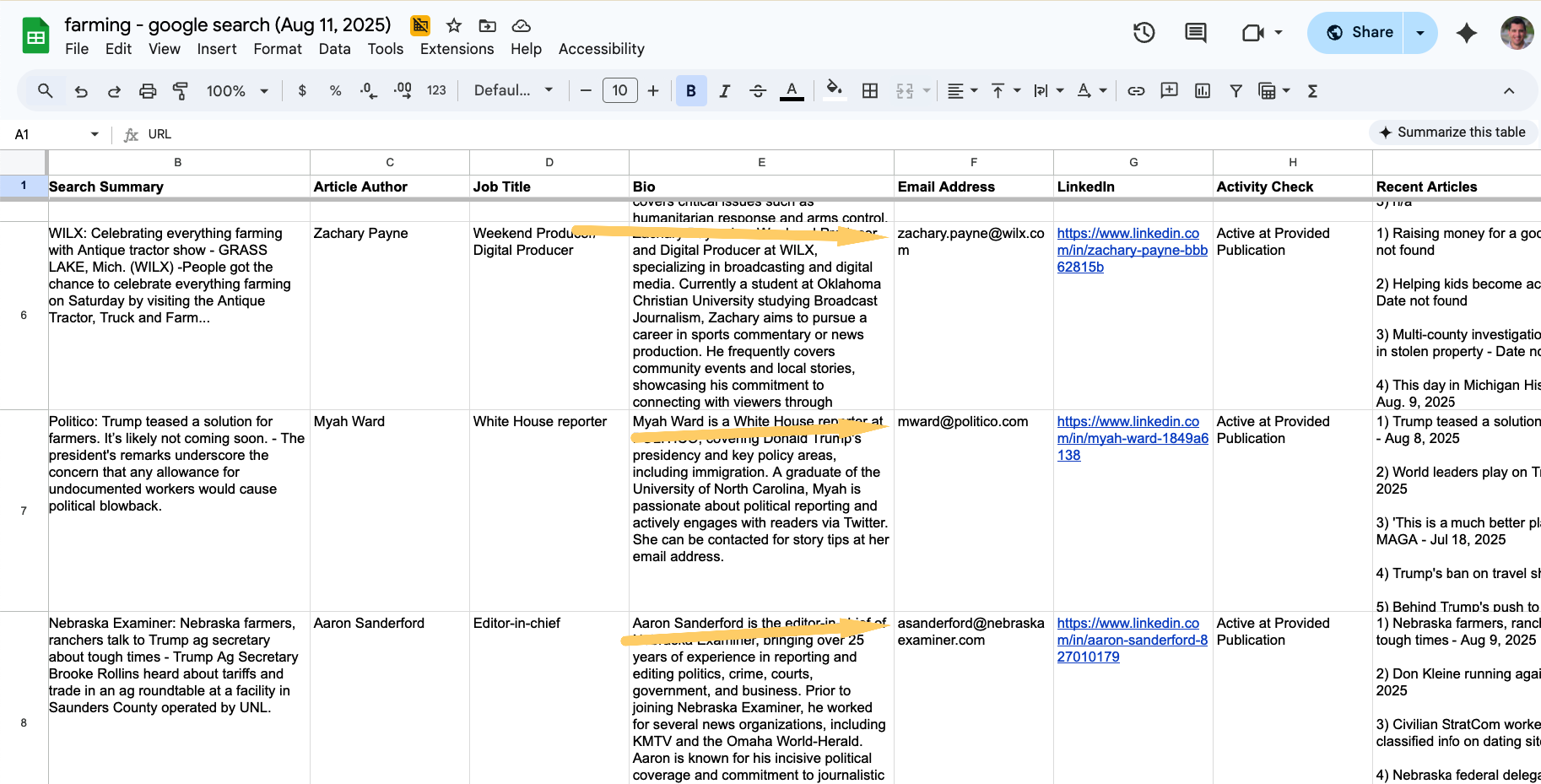
The advantage of using a tool like ListIQ for finding email addresses is that it doesn’t guess, unlike most email finder tools available. ListIQ’s contact info comes from verified email addresses.
BuzzStream BuzzMarker
When you are on a page, BuzzStream will automatically comb the site and extract any email addresses and social accounts it can find using the Chrome Extension Buzzmarker.
For example, I wanted to look at Newsday’s Mark Harrington, who appeared on my X search for farming reporters. When I open Newsday, you can see BuzzStream extracting all the emails it can find (including Mark’s).

Google Search
Even if the publication doesn’t list its name, it can usually still be found using Google search. Often, their name, the publication, and the word email can be enough.
For example, let’s back up to the Irish Examiner example. That site doesn’t have a list of contact information on their site for each reporter, writer, or anchor.
So, a quick Google Search unveiled Kathleen O’Sullivan’s email right in the search results via X:

Now that you’ve got your email address for your journalist. You can craft your email.
2. Craft your Email
As I mentioned, emailing journalists is the best way to contact them.
Not every pitch is the same, but they all have similar components.
We’ve covered all of them in our email templates post, but here’s a basic structure for pitching a data study:

The idea is to include everything the journalist would need to write the post without needing to back.
In our podcast interview with Hannah Smith, she reiterated some of the best advice I’ve ever heard when contacting journalists:
“I’ll look at my pitch and I’ll be like, could the journalist write this story in 15 minutes just using my pitch…so if I get a paragraph or two in, and I’m suddenly Googling trying to find some sort of stat or some sort of other reliable bit of research, I’m like, “oh, I need to reference that in my email then.”
Email with BuzzStream
Now that I’ve got a vetted and qualified list of relevant journalists and know how to reach them, I can begin sending emails.
Using BuzzStream, I can easily email journalists from my outreach list at scale while still being able to personalize the emails to make them effective.
First, I go to the Outreach List in the navigation.
Then, I’ll click the checkbox at the top to select all of my prospects.

Next, I click Outreach and choose Send Individually. Then I’ll see the option to choose a template or sequence.
I click New Sequence to create something brand new for my project.

First, I’ll name my Sequence (so I can quickly find it later when needed).
Then, I’ll fill out my template using the Dynamic Fields on the right.

I can also enable a follow-up email if I don’t receive a response.

Then, I can work through my outreach list individually to personalize each email. On the left, I see any contact history my team or I might have had with a particular site.
On the right, I see the email outreach that I’ll be sending.

Then, BuzzStream keeps track of all the responses in my Dashboard so that I can easily see who has responded, linked, etc.
3. Pitching Via Social Media
Based on the same MuckRack study, most journalists receive ~3-5 pitches daily. So, some choose to pitch using social media.
If I ever decide to contact a journalist via social media, I lean heavily on X, given that is the preferred platform for most.
Journalists who want to be connected will keep their DMs open. You’ll see an envelope icon next to their follow button.

Keep your contact short and sweet:
Hi Kathleen – I’ve got a great new study on crop technology that I thought you might like. Mind if I send it along?
I sometimes like to use the double-touch technique: I email them and then DM them on X to let them know I’ve reached out:
Hi Kathleen – Just a heads up: I emailed you a new crop technology study that is right in your wheelhouse.
This puts you on their radar.
Some digital PRs recommend following and interacting with a journalist on X before pitching.
This is excellent advice if you plan on being in the industry for a long time and want to build relationships with journalists.
If you only pitch one-off pitches, it’s unnecessary and will likely not impact much.
4. Quote Requests
The last way to contact a journalist is through a journalist request platform. Although this slightly differs from other tactics listed in this post, it’s still worth mentioning.
This is more of an opportunistic approach to digital PR vs a tactic for pitching stories.
There are several platforms there.
- Connectively (formerly known as HARO)
- HERO
- Qwoted
- @PRJournorequest on X
Each platform requires setting up an account and keeping track of requests that come in daily.
For example, I utilize Qwoted to find opportunities to pitch quotes from myself in the digital marketing space.

You can also set up your own for specific industries.
HARO used to be the go-to but has waned in quality since Cision purchased it and renamed it Connectively. Luckily, the founder of HARO recently created H.E.R.O. or Help Every Reporter Out.

Simply sign up, and you’ll receive a daily email with pitch requests from journalists broken down by industry and detailed instructions for pitching.

Lastly, with X, the account @PRJournoRequest compiles all instances of Tweets that use #journorequest or #prrequest.
These two hashtags are the go-to ways many UK journalists source quotes for their pieces.
They are not used as much in the US, though as digital PR continues to grow in popularity, perhaps we’ll see US journalists utilize this approach as well.
Why It’s So Important to Pitch Relevant Journalists in 2024
We are in very interesting times.
Journalists are getting laid off around the globe, yet more agencies and teams are turning to digital PR for answers.
So we have an influx of pitches to an ever-shrinking number of journalists.
Google has also implemented new email requirements to prevent mass nonrelevant emails to personal email addresses.
They now require “bulk senders” — or those who send 5,000 or more emails within 24 hours from the same domain to personal Gmail addresses — to adhere to new security requirements.
Those who do not will hit spam filters, rendering their outreach useless.
Luckily, there is a simple solution: hyper-targeted pitches. The more targeted and personalized your pitch emails are, the easier it is to build relationships with journalists.
And I know that the term “building relationships” sounds fluffy, but it has real business value.
Once you’ve established a relationship with a journalist, you can pitch them again for the same client (or new clients) with little to no barrier to entry.
You’ve already established trust, and as long as you don’t abuse it by pitching non-relevant pieces, you can start to build your Rolodex of journalists you can count on for links.
So, while the workflows I’ve outlined in this piece may sound time-consuming, you realistically only need to do them one time and can reap the benefits for each subsequent campaign.

 End-to-end outreach workflow
End-to-end outreach workflow



 Check out the BuzzStream Podcast
Check out the BuzzStream Podcast







